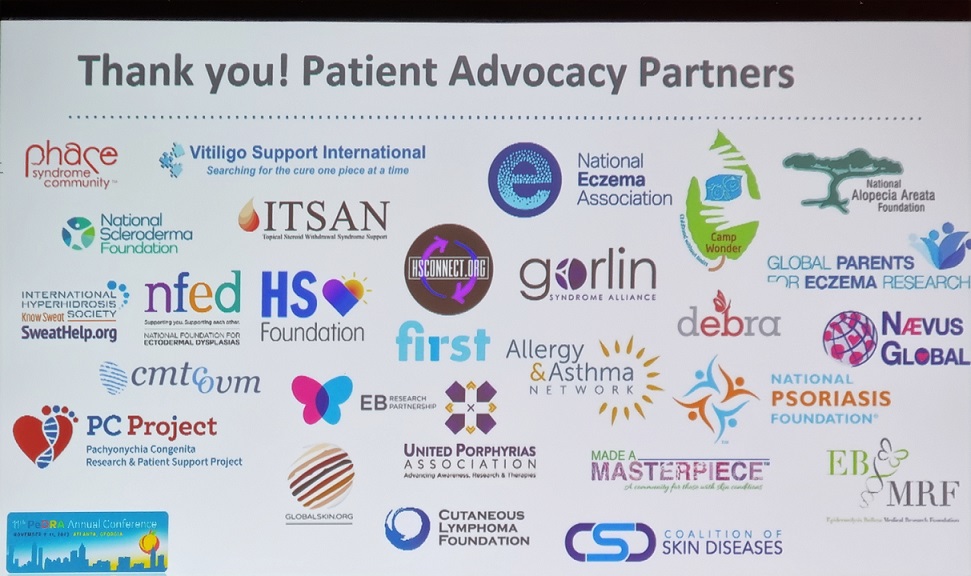As one of the many Patient Organizations, we visit all kinds of conferences with the main goal of making the patient’s voice heard and contributing to improving the quality of life of the patient and his/her family. Because what is it really about? The patient!
And what is a doctor doing? He also contributes to the quality of life of a patient!
It is therefore crucial that doctors and Patient Organizations work together to improve the quality of life of the patient. As a Patient Organization we also directly involve the family.
At conferences such as PEDRA and ISSVA, the position of Patient Organizations is very clear! Here we are directly involved in the conference, our stands have a very good and visible location and we are taken seriously. We also work together with these organizations outside of the conferences.
Unfortunately, this is not yet the case everywhere. It often turns out that doctors do not (yet) see the value of Patient Organizations, the concept of ‘shared decision-making’ has not yet penetrated to them.
That is why we take our responsibility and describe the added value of Patient Organizations for doctors.
What is the added value of a Patient Organization for doctors?
Patient organizations offer several key benefits to medical professionals, providing valuable insights, resources, and collaboration opportunities that enhance patient care and professional development. Here are some of the main added values:
- Patient-Centered Insights
Deeper Understanding of Patient Experiences: Patient organizations can offer direct feedback on how patients experience diseases, treatments, and the healthcare system, giving professionals a more complete picture of patient needs and expectations.
Identification of Unmet Needs: Medical professionals can better understand gaps in care, support services, or education that patients may require but are not getting, helping them to tailor interventions more effectively.
- Educational Resources and Awareness
Access to Patient-Focused Educational Materials: Organizations often produce easy-to-understand materials about conditions, treatments, and living with chronic diseases that can supplement what healthcare providers give to patients.
Training for Healthcare Providers: Some patient organizations offer educational programs, workshops, or conferences that are specifically designed to update professionals on the latest advancements in managing a condition from a patient’s perspective.
- Improved Patient Engagement and Adherence
Enhancing Communication with Patients: Insights from patient organizations can help clinicians communicate more effectively with patients, fostering a greater sense of trust and partnership in care, which is crucial for treatment adherence.
Support Networks: These organizations often provide peer support, which can motivate patients to adhere to treatments and attend follow-up appointments, improving overall health outcomes.
- Research Collaboration
Input for Clinical Research: Patient organizations can assist in research by offering patient registries, helping with clinical trial recruitment, and ensuring that research addresses relevant patient concerns and quality-of-life outcomes.
Promoting Patient Involvement in Research: By working with these organizations, healthcare professionals can involve patients as co-researchers or advisors, ensuring studies are patient-centered.
- Advocacy and Policy Influence
Shaping Healthcare Policies: Patient organizations often advocate for policies that improve access to care, treatment, and services. Medical professionals can collaborate with these organizations to push for healthcare reforms or changes in clinical guidelines that benefit patients.
Access to Grants and Funding: Through patient organizations, healthcare providers can sometimes access funding for research or patient care initiatives that align with the organization’s goals.
- Enhancing Professional Credibility and Ethical Practice
Aligning with Patient-Centered Care Models: Working with patient organizations enhances the professional’s commitment to patient-centered care, which is increasingly becoming a standard in healthcare systems worldwide.
Ethical Collaborations: These partnerships emphasize transparency, fairness, and a balanced approach to patient care, which can strengthen trust between patients and the medical community.
- Holistic Patient Care
Addressing Psychosocial Aspects: Medical professionals may rely on patient organizations to provide support for the psychosocial challenges of illness, such as mental health concerns, coping strategies, or financial assistance, ensuring a more holistic approach to care.
Long-Term Patient Support: Patient organizations offer ongoing support beyond clinical visits, helping patients manage chronic conditions over time, which complements the work of healthcare providers.
In summary, patient organizations provide medical professionals with patient-centric insights, resources, and collaboration opportunities, enhancing their ability to deliver personalized, empathetic, and effective care.
